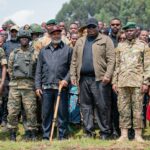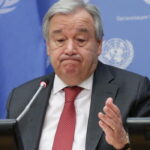History is being made in America’s northernmost state. For the first time in a decade, Russian President Vladimir Putin has stepped onto U.S. soil for a high-stakes meeting with U.S. President Donald Trump. The goal: find a way to end the war in Ukraine.
The talks are taking place at the U.S. military’s Joint Base Elmendorf-Richardson, a secure and symbolic location chosen for its strategic position and distance from Washington politics. Both leaders have arrived, and the world is watching every move.
Trump believes he can convince Putin to make a deal to stop Moscow’s war against Ukraine, though he has not revealed exactly what conditions he will demand. For Trump, this is more than diplomacy, it’s a chance to shape his legacy as a peacemaker.
For Putin, the summit offers a rare chance to shift global perception without having to meet directly with Ukrainian President Volodymyr Zelenskyy, something the Kremlin has resisted for years.
📰 Also Read This:
Notably, Zelenskyy was not invited to the first round of talks. Trump says he hopes the Ukrainian leader will join a “second round” if progress is made in Alaska. But the question remains: will there even be a second meeting?
Speaking to reporters aboard Air Force One on the way to Alaska, Trump was asked what would define a successful summit. His answer was blunt: “I can’t tell you that. I don’t know. I want certain things. I want to see a ceasefire. This is nothing to do with Europe. Europe’s not telling me what to do.”
Meanwhile, Russian state news agencies RIA Novosti and Tass confirmed that Putin’s top delegation, including Foreign Minister Sergey Lavrov, Defense Minister Andrei Belousov, Finance Minister Anton Siluanov, and Putin’s investment envoy Kirill Dmitriev, has arrived at the venue.
Putin himself landed in Alaska later in the evening, marking his first trip to the U.S. since 2015, when he attended the United Nations General Assembly in New York. His arrival was met with tight security and a brief greeting by Trump at the airfield.
White House press secretary Karoline Leavitt revealed that the meeting would not be a one-on-one encounter. Instead, it will be a “three-on-three” session. Trump will be joined by Secretary of State Marco Rubio and his special envoy Steve Witkoff.
Putin will have Lavrov and Belousov at his side. Later, a working lunch will bring in more top officials, including Treasury Secretary Scott Bessent, Commerce Secretary Howard Lutnick, Defense Secretary Pete Hegseth, and White House Chief of Staff Susie Wiles.
By late morning in Anchorage, both leaders were inside Elmendorf Air Force Base, where talks began behind closed doors. No details of the opening remarks have been released.
Back in Ukraine, President Zelenskyy delivered a pointed message in his nightly address. He said that while the world talks about peace, Russia continues to launch deadly strikes.
“Sumy – a Russian strike on the central market. Dnipro region, strikes on cities and enterprises. Zaporizhzhia, Kherson region, Donetsk region, deliberate Russian strikes. The war continues, and it is precisely because there is neither an order nor even a signal that Moscow is preparing to end this war,” Zelenskyy said.
His frustration was clear: “On the day of negotiations, they are killing as well. And that speaks volumes. Recently, we’ve discussed with the U.S. and Europeans what can truly work. Everyone needs a just end to the war.”
Zelenskyy emphasized Ukraine’s readiness to work “as productively as possible” to end the conflict, but warned that much depends on America’s stance: “Everything will depend on this, the Russians factor in American strength. Make no mistake, strength.”
The Alaska summit is being closely monitored by NATO. Supreme Allied Commander Europe, General Alexus Grynkewich, is reportedly providing military advice to President Trump and Defense Secretary Pete Hegseth during the talks. His presence signals that any agreement will be judged not just politically, but strategically.
European leaders are watching nervously, hoping Trump will hold a firm line against Putin. Many fear a deal could be struck that benefits Moscow at Kyiv’s expense.
For now, the talks continue in Anchorage. Whether they end in breakthrough, deadlock, or a dramatic walkout remains unknown. But one thing is certain: the decisions made in Alaska could shape the future of Europe, and the world.







